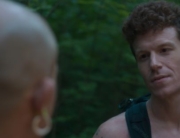
Tom Colicchio in A PLACE AT THE TABLE (Magnolia Pictures)
A Place at the Table updates the galvanizing 1968 TV documentary Hunger in America in a rambling grab bag overview, but makes convincing links to the causes of the much bruited obesity epidemic. Between the impassioned talking-head experts (as well as committed celebrities for adroit media attention), directors Lori Silverbush (wife of executive producer/Top Chef’s Tom Colicchio) and Kristi Jacobsen follow three sympathetic females struggling with hunger problems on a daily basis and the people trying to help them. In doing so, they personalize the larger context and bring it all very much home.
The most informative profile features Tremonica, an overweight, asthmatic second-grader in the small largely African-American town of Jonestown, Mississippi (the state that was the focus of the original CBS documentary). That her mother stretches her limited budget by filling up her family on inexpensive processed food provides a taking off point for a discussion of “food deserts” in rural and urban neighborhoods, where affordable fresh food is not readily available. Marion Nestle, noted public health scholar and advocate, rails against how U.S. agricultural policy favors agribusiness food processers to keep their products’ prices down, accompanied by several charts noting ill-directed government subsidies and the spending on lobbyists.
The director of the local community health center decries that his heavy patients are beset by diabetes and other diseases, and Tremonica’s charismatic teacher, Odessa Cherry, demonstrates the basics about fruits and vegetables in the school’s award-winning nutrition education program. As surprising as it is that rural kids haven’t ever sampled a melon, it’s odd that no farmers are interviewed, not even Farm-Aid or an organization promoting farmers’ markets, even as the logistical problems of supermarket chains’ deliveries are briefly mentioned. Michelle Obama is glimpsed at one White House garden event, but with no analysis of the effectiveness of her various anti-obesity efforts.
The audience’s salty tears will be added to the experiences of Barbie, a young, single African-American mother of two small children in Philadelphia. She is stymied by the difficulty of living each month on the Supplemental Nutrition Assistance Program (SNAP) allowance, formerly called food stamps, which replaced agricultural surplus food distributions. (Massachusetts Congressman James McGovern, co-chair of the Congressional Hunger Center, admits he gave up trying to live on these restrictions after a week.)
As determined as Barbie is to avoid feeding her kids Chef Boyardee, she is heartbreakingly defeated into resorting to those high sodium and carbohydrate meals when a new (discouraging) job at a hunger hotline puts her just over the eligibility for government assistance. She turns into a confident lobbyist as part of Dr. Mariana Chilton’s Witness to Hunger troupe of 40 local mothers, but the more she’s seen on screen getting involved in such efforts, the more she mouths advocates’ rhetoric rather than naturally expressing her own travails and frustrations. Her lobbying comes to naught at a Congressional agricultural committee session, where the budget pie is just further divided amongst hungry constituents without any subsidies taken away from the big food producers. Too bad none of those interests are interviewed.
The portrait of Rosie, a fifth grader in Collbran, Colorado, is the most problematical, and points out the weakness in the film’s disjointed organization (I may be making it sound more cohesive than it is) as it leaves tantalizing issues on the floor. Rosie’s extended family’s problems leave her too hungry to do well in school. Her teacher, Leslie Nichols, helps Rosie by providing extra tutoring, and volunteers to make free food deliveries from the stock her pastor picks up from a distant food bank. But for all the screen time spent following the dedicated pastor as he supervises cooking free community meals and making long pick-up trips for the handouts, it is absolutely shocking when Rosie’s grateful family opens the charitable bags and finds them full of junk food. Though her teacher is embarrassed, it’s certainly not her fault. Why didn’t the filmmakers follow the investigative chain about food banks? One could become cynical that it may be because donors like Kraft and PepsiCo also contribute to the advocacy organizations talking and talking throughout the film. As moving as the real lives are, and for a film clearly intending to be a call for action, hunger cries out for more journalism and not just depressing stories and statistics.






“..hunger cries out for more journalism and not just depressing stories and statistics.” What?? Hunger IS depressing and statistics are important. How will journalism change that or provide a better prospective than this film?
Thanks for reading my review. What the film lacks, and what is needed to spur policy changes, is investigative journalism about the problems identified, not just emotions and stats.